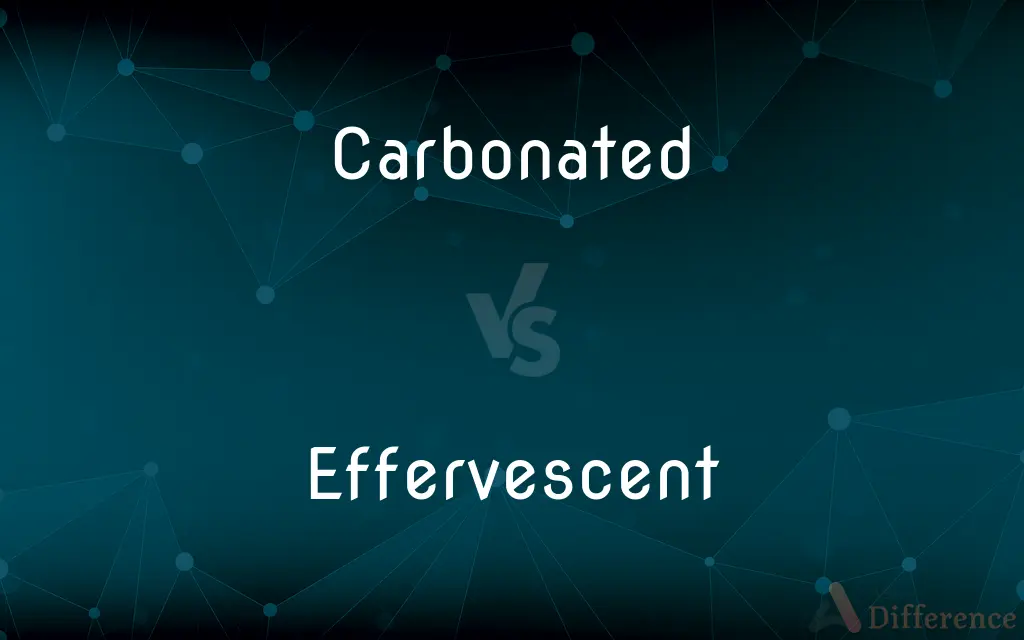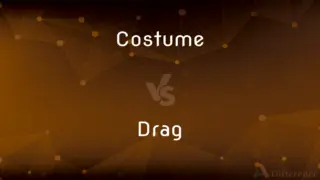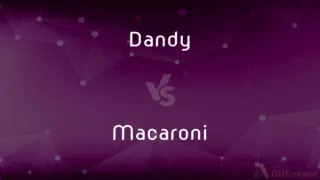Carbonated vs. Effervescent — What's the Difference?
By Maham Liaqat & Fiza Rafique — Updated on April 6, 2024
Carbonated drinks contain dissolved CO2 under pressure, creating fizz. Effervescent involves releasing gas, often through a chemical reaction, for a similar effect.

Difference Between Carbonated and Effervescent
Table of Contents
ADVERTISEMENT
Key Differences
Carbonated drinks are infused with carbon dioxide under high pressure, leading to the formation of bubbles and fizz when the pressure is released. This process is common in beverages like sodas and sparkling waters, where the carbonation is intentional and adds to the texture and taste of the drink. Whereas effervescent substances release gas as a result of a chemical reaction, typically when a solid dissolves in a liquid. This reaction does not require pressurization and can occur in medicinal tablets that fizz when dropped into water, enhancing the drinking experience and sometimes aiding in the faster absorption of the medication.
Carbonation is a physical process that involves dissolving CO2 in a liquid under high pressure. When the pressure is reduced, such as when opening a bottle of soda, the CO2 escapes in the form of bubbles. On the other hand, effervescence is often a chemical process where ingredients such as citric acid and sodium bicarbonate react upon dissolving in water, producing carbon dioxide gas as a byproduct. This distinction highlights the different mechanisms behind the fizz in carbonated and effervescent products.
In terms of sensory experience, carbonated beverages can provide a sharp, tingling sensation due to the bubbles formed by the escaped CO2. This sensation is a significant part of the appeal for products like sparkling water and soda. Effervescent products, while also producing bubbles and fizz, might offer a slightly different sensory experience due to the nature of the gas release and the potential presence of additional flavors or medicinal ingredients designed to dissolve in water.
Regarding their uses, carbonated drinks are primarily consumed for enjoyment and hydration, available in a wide range of flavors and sweetness levels. Effervescent products, while they can also be enjoyed purely for their taste and texture, are often formulated for specific health benefits, such as providing vitamins, minerals, or medications in an easily digestible form.
The storage and stability of carbonated versus effervescent products can differ. Carbonated beverages require sealed containers to maintain their pressure and fizz. Once opened, they can quickly lose their carbonation if not consumed promptly. Effervescent products, typically in solid form until use, have a longer shelf life when kept dry and react only when exposed to water, offering a practical advantage for storage and transport.
ADVERTISEMENT
Comparison Chart
Process
Physical infusion of CO2 under pressure
Chemical reaction releasing gas
Example Products
Sodas, sparkling water
Fizzy health drinks, antacid tablets
Sensory Experience
Sharp, tingling sensation from bubbles
Fizz and potentially different flavors
Uses
Enjoyment, hydration
Health benefits, medication delivery
Storage Stability
Requires sealed containers, loses fizz
Long shelf life in dry form, reacts with water
Compare with Definitions
Carbonated
Requires sealed packaging to maintain its carbonation.
Once opened, the carbonated drink should be consumed quickly to retain its bubbles.
Effervescent
Does not require pressurization for the effervescence to occur.
Effervescent reactions happen upon the tablet's contact with liquid.
Carbonated
Infused with carbon dioxide gas under pressure to create bubbles.
Carbonated water becomes fizzy due to the high pressure of CO2.
Effervescent
Often utilized for delivering medications or supplements in a digestible form.
Effervescent vitamin C is a popular choice for immune support.
Carbonated
Offers a tingling sensation and is commonly found in beverages.
The carbonated soda provided a refreshing fizz.
Effervescent
Has a stable shelf life until it reacts with water.
Effervescent tablets remain potent until dissolved in water.
Carbonated
Popular in the beverage industry for creating sparkling drinks.
Carbonated drinks are a staple at parties for their effervescent quality.
Effervescent
Provides a sensory experience that can enhance the enjoyment of consuming medicines.
Kids prefer the effervescent form of medication for its fizzy taste.
Carbonated
Can lose its fizz upon opening as the CO2 escapes.
The carbonated beverage went flat after being left open overnight.
Effervescent
Relates to the bubbling of a liquid caused by the gas released in a chemical reaction.
The effervescent tablet fizzed up when dropped into water.
Carbonated
To add carbon dioxide gas to (a beverage) so that bubbles are produced upon release from a container.
Effervescent
To emit small bubbles of gas, as a carbonated or fermenting liquid.
Carbonated
To burn to carbon; carbonize.
Effervescent
To escape from a liquid as bubbles; bubble up.
Carbonated
To change into a carbonate.
Effervescent
To show high spirits or animation.
Carbonated
The anionic divalent group CO3, derived from carbonic acid, or a compound containing this group.
Effervescent
(of a liquid) Giving off bubbles; fizzy.
Carbonated
Containing carbon dioxide gas under pressure, especially pertaining to beverages, as natural mineral water or man-made drinks.
Soda pop, lemon soda and soda water are carbonated drinks. Champagne and beer are naturally carbonated through fermentation.
Effervescent
Vivacious and enthusiastic.
Carbonated
(mineralogy) Containing calcium carbonate, often as a result of mineral carbonation.
Effervescent
Gently boiling or bubbling, by means of the disengagement of gas
Carbonated
Simple past tense and past participle of carbonate
Effervescent
Used of wines and waters; charged naturally or artificially with carbon dioxide;
Sparkling wines
Sparkling water
Carbonated
Combined or impregnated with carbonic acid.
Effervescent
(of a liquid) giving off bubbles
Carbonated
Having carbonation (especially artificially carbonated)
Effervescent
Marked by high spirits or excitement;
His fertile effervescent mind
Scintillating personality
Sparkling conversation
A row of sparkly cheerleaders
Common Curiosities
What causes carbonated drinks to fizz?
Carbonated drinks fizz due to the release of CO2 gas when the pressure inside the container is decreased.
Are all fizzy drinks carbonated?
Not all fizzy drinks are carbonated; some are effervescent, relying on a chemical reaction to produce fizz.
Why do carbonated drinks go flat?
Carbonated drinks go flat because the CO2 gas escapes from the liquid once the container is opened and the pressure is released.
Can effervescent products be used for hydration?
Yes, effervescent products, especially those containing vitamins or minerals, can be used for hydration and nutritional supplementation.
Are effervescent drinks healthier than carbonated ones?
Effervescent drinks can be healthier if they contain vitamins or minerals, but it depends on the specific products and their ingredients.
How do effervescent tablets work?
Effervescent tablets work by dissolving in water, causing a chemical reaction that releases CO2 gas, leading to fizz.
Can carbonated drinks cause health issues?
Excessive consumption of sugary carbonated drinks can lead to health issues like dental decay and obesity.
Do effervescent tablets expire?
Effervescent tablets do have an expiration date, after which their effectiveness might decrease.
Why do some medications come in effervescent form?
Some medications are effervescent for easier digestion, quicker absorption, and to make them more palatable.
Can I make a drink carbonated at home?
Yes, you can carbonate drinks at home using carbonation machines or DIY methods involving CO2 cartridges.
Is the fizz in carbonated and effervescent drinks the same?
While the fizz in both types of drinks is caused by CO2 gas, the method of gas release differs, potentially affecting the sensory experience.
Can I reuse a carbonated drink bottle for homemade drinks?
Yes, but only if you have a way to reseal it effectively to maintain carbonation.
How are effervescent drinks flavored?
Effervescent drinks are flavored using natural or artificial flavorings added during the tablet-making process.
What's the difference between sparkling and carbonated water?
Sparkling water is naturally carbonated from a spring or well, while carbonated water is artificially infused with CO2.
Share Your Discovery

Previous Comparison
Costume vs. Drag
Next Comparison
Dandy vs. MacaroniAuthor Spotlight
Written by
Maham LiaqatCo-written by
Fiza RafiqueFiza Rafique is a skilled content writer at AskDifference.com, where she meticulously refines and enhances written pieces. Drawing from her vast editorial expertise, Fiza ensures clarity, accuracy, and precision in every article. Passionate about language, she continually seeks to elevate the quality of content for readers worldwide.















































